Abstract
Shale in the Wufeng Formation of the upper Ordovician and Longmaxi Formation of lower Silurian in the Sichuan Basin and its surrounding area is widespread. Shale gas resources are abundant. Shale gas in the Wufeng Formation and the Longmaxi Formation in the basin has been a major breakthrough. The basin margin transition zone in southeastern Chongqing is in an intense tectonic activity area, which is more complicated and special than the stable stratum in the basin. Therefore, it is necessary to put forward higher requirements for preservation conditions and enrichment pattern evaluation of shale gas. Therefore, in view of the complicated structural pattern of the basin margin transition zone in southeastern Chongqing, the preservation conditions and reservoir forming patterns are analyzed through structural evolution, uplift and denudation, fault development, structural styles, roof and floor conditions, and formation pressure. The results show that the main reason for the formation of normal pressure is the late uplift, denudation and fault development. The pressure coefficient from the basin to the outer layer is changed from overpressure to normal pressure, and structural transformation forms the preservation form of shale gas with narrow and steep residual anticline, wide residual syncline and residual slope. The preservation condition evaluation of normal shale gas should be based on structural factors such as structural evolution, structural style, uplift and denudation degree and fault development degree, with formation pressure coefficient as reference condition, combined with material basic conditions such as roof and floor conditions and formation thickness. The findings of this study can help for better understanding of the “sweet spot” prediction of normal pressure shale gas in complex structural area.
1. Introduction
The Wufeng Formation of Upper Ordovician (O3w) and Longmaxi Formation of Lower Silurian (S1l) shale gas is widely distributed in the Sichuan Basin and its periphery. Among them, Fuling, Changning, Weiyuan and other large commercial shale gas fields have been built and put into operation in the basin [1,2]. In the Sichuan Basin, O3w-S1l is a set of stable, deep shelf sediments with large stratum thickness and a relatively stable structure [3]. At present, a relatively mature enrichment model of marine facies shale gas in the basin has been formed, that is, high-quality shale in a deep-water shelf is the basis of “hydrocarbon generation and storage control” of shale gas, and good preservation conditions are the key to “reservoir formation and production control” of shale gas [4,5].
Now, the focus of exploration and development has been on the periphery of the basin with more complex geological conditions [6]. Especially outside the basin, although it belongs to the same set of strata, due to different transformation conditions in the later stage, the geological characteristics of Silurian Longmaxi Formation are very different from inside the basin to the edge of the basin, and the enrichment mode of shale gas is different from that of the basin. For example, Longmaxi Formation shale encountered in PY1 well in Pengshui area is located at the wing of wide and gentle syncline outside the basin. Although industrial gas flow is obtained, the stable production is 2.52 × 104 m3/d, far less than the interior of the basin [7,8,9].
The southeast Chongqing basin margin transition zone is located in the southeast margin of Chongqing, China and some areas in the north of Guizhou Province. It is a gradual transition area from the Sichuan basin to outside the basin from west to east (Figure 1). O3w-S1l in the area has experienced multi-stage tectonic movement and overpressure relief process, forming a series of gas reservoirs with distinctive normal pressure characteristics. In the basin, the formation pressure coefficient is mostly greater than 1.2, while it is generally less than 1.2 in southeast Chongqing [10,11].
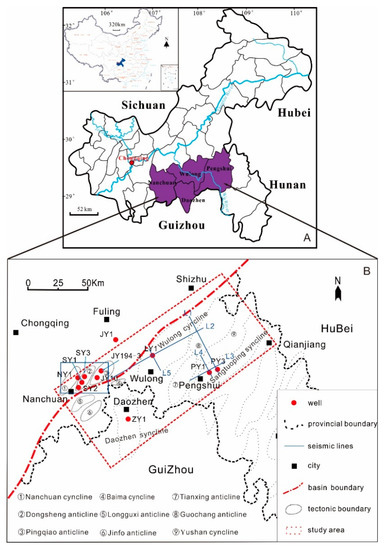
Figure 1.
Geographical location of basin margin transition zone in the study area.
Yuan [12] believed that the formation of a normal pressure shale gas reservoir was affected by mudstone over-consolidation ratio. Structural conditions affect the distribution of normal pressure shale gas reservoirs. In the southeast, the Sichuan shale gas has formed normal pressure shale gas reservoir models such as high-quality shale loss/thinning type, early escape type, fault failure type and residual syncline type [13]. Deep shelf facies high-quality shale is the basis of shale gas enrichment, and the preservation condition is the key factor for shale gas enrichment and high yield [14]. Predecessors have formed a certain understanding of the formation mechanism of normal pressure shale gas and the enrichment mode of normal pressure shale gas. At the same time, some also believe that the preservation conditions are the key research content of atmospheric pressure shale gas. However, in China, the exploration and development of normal pressure shale gas has just begun, there is no unified understanding of the formation mechanism of normal pressure shale gas, and a systematic evaluation of the preservation conditions has not been formed. The formed shale gas enrichment model is not enough to accurately guide the development of shale gas in the basin margin conversion zone.
In this paper, aiming at the complex structural pattern of Longmaxi Formation in the transition zone of the southeast Chongqing basin margin, from inside to outside the basin, the preservation conditions are studied. This is achieved through the analysis of the main controlling factors such as structural evolution, uplift and denudation, fault development, structural style, roof and floor conditions and formation pressure. Additionally, the normal pressure shale gas reservoir forming model suitable for the transition zone of southeast Chongqing basin margin is established. This has a guiding role for the “dessert” evaluation of normal pressure shale gas in the study area and outside of the Sichuan Basin.
2. Geological Setting
The southeast Chongqing basin margin transition zone is located in the southeast edge of the Sichuan Basin. The southeast area of the Sichuan Basin is bounded by the Qiyueshan fault to form the southeast Sichuan fold belt on the inner side of the basin margin and the Xiangexi qiandongbei fault fold belt on the outer side. The study area is located in the mutual transition area of the middle and south sections of two primary structural units, forming a series of northeast–southwest trending synclines and anticlines [15,16]. The three groups of main anticline belts (Fangdoushan anticline, Jinshan–Suiyang anticline and Zhongyang anticline) are relatively closed, embedded with a series of synclines, such as Wulong syncline and Pengshui syncline, which generally form as NNE extensions and diffusion patterns [17,18].
The study area is located in the favorable position of deep-water shelf sedimentary facies in the detention basin surrounded by central the Sichuan ancient land, Central Guizhou Uplift and Xuefeng uplift [19,20]. The study area is located in the favorable part of the sedimentary facies of the deep-water shelf in the detention basin surrounded by the central the Sichuan ancient land, the central Guizhou uplift and the Xuefeng uplift, creating a closed and stagnant anoxic hydrostatic reduction environment during the deposition period, forming fine-grained sediments with high organic matter such as black siliceous shale, carbonaceous shale and biological fossils in O3w and the first section of S1l (Long 1), which is a typical deep-water shelf facies deposit [21,22,23]. The thickness of dark shale is about 90–120 m, while high-quality shale (TOC > 2%) is mainly developed in ww and the lower part of the Long 1, with a thickness of about 30 m (Figure 2).
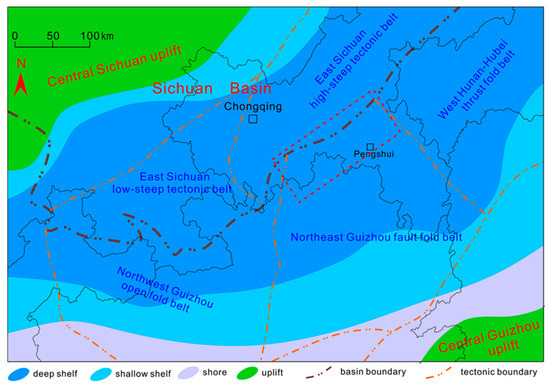
Figure 2.
Tectonic framework and sedimentary facies in southeast Chongqing.
3. Data and Method
3.1. Data
Data analyzed in this study include seismic lines and wells data. They were provided by the East China oil and gas company of Sinopec. Seismic data include 168 km2 3D seismic data (Table 1) and 5 2D seismic lines (Table 2), which were arranged, collected and processed by the Sinopec East China oil and gas branch before 2015.

Table 1.
Parameters of the 3D seismic grid.

Table 2.
Parameters of 2D seismic lines.
The well data of four representative areas in the current study area are used in the study, including wells SY1, SY2, SY3 and JY10 in Nanchuan area (NC), LY1 and LY2 in Wulong area (WL), PY1 and PY3 in Pengshui area (PS) and ZY1 in Daozhen area (DZ). The drilling depth of these wells is 2000–4500 m. Most of the well data include logging data, measured TOC content, lithology data, formation pressure coefficient, gas content and actual gas production. The characteristics of each well are presented in Table 3.

Table 3.
Well data in the study area.
3.2. Methodology
The process includes the following steps: (1) The lithologic and stratigraphic data of each well from Late Ordovician to Lower Silurian are counted; (2) The strata are divided according to the stratigraphic characteristics; (3) The strata with total organic carbon content greater than 2% are divided into high-quality shale sections, and the average total organic carbon content, average organic matter maturity and formation pressure of high-quality shale are counted; (4) According to the logging data, the causes of normal pressure formation in Longmaxi Formation are analyzed.
Based on the log interpretation data, the standard seismic stratigraphy and structural interpretation technology are used to interpret the second and third dimensional seismic data in the study area. The methods are summarized as the following: 1. Well seismic calibration; 2. Main fault interpretation and stratigraphic interpretation; 3. Analysis of seismic interpretation results combined with geological data.
(1) According to the characteristics of logging petroelectricity, velocity and seismic profile, the characteristics of the reflector at the bottom of Wujiaping Formation of Middle Permian (P2w), Liangshan Formation of Lower Permian (P1l), Wufeng Formation of upper Ordovician (O3w), Shuijingtuo Formation of lower Cambrian (Є1s) and Dengying Formation of Sinian (Z2dn), are mainly determined.
(2) In the process of interpretation, the front and back correlation, new and old correlation, real-time adjustment of fault combination and reasonable establishment of interpretation model are adopted. At the same time, the principle of equal thickness of stratum and consistent occurrence of stratum in the same fault block is adhered to, and the change of stratum thickness caused by interlayer slippage and plastic flow of stratum is considered. Due to folding and faulting, Mesozoic Paleozoic strata are exposed to varying degrees. This interpretation is mainly carried out on the basis of fine well calibration, according to the geological map, combined with the reflection characteristics and structural characteristics of adjacent areas.
4. Results
4.1. Well Data Analysis
All wells were drilled to the bottom of Wufeng Formation of Upper Ordovician. The well data show that the target strata in the study area are developed from the Wufeng Formation to Longmaxi Formation, and the average thickness of the Wufeng Formation is 5 m. The thickness of Longmaxi Formation is 320–380 m, including 75–85 m of the first section of Longmaxi formation. Overlying strata of the Longmaxi Formation are the Xiaoheba Formation of Lower Silurian and Hanjiadian Formation of middle Silurian. The underlying strata of the Wufeng Formation are Linxiang Formation of Upper Ordovician and Baota Formation of Middle Ordovician.
Through the analysis of O3w-S1l in the well data, the pressure coefficient of Longmaxi-Wufeng Formation in the basin is generally greater than 1.2, and the change in plane distribution is relatively stable. Pressure coefficient of Longmaxi-Wufeng Formation outside the basin is generally less than 1.2, which is randomly distributed horizontally, and there are gradient differences in different regions. Located in Nanchuan area west of Qiyueshan fault, the formation pressure coefficient of well NY1 is 1.35 and that of SY1 well is 1.36. The buried depth of Longmaxi Formation of these wells is greater than 3000 m. The formation pressure of well LY1, well LY2, well PY1 and well PY3 in Wulong area to the east of Qiyueshan fault is less than 1.1, and the buried depth of Longmaxi Formation of these wells is less than 3000 m (Table 4).

Table 4.
Parameters of representative wells in southeast Chongqing. Depth refers to the bottom elevation depth of O3w. The value of pressure coefficient and TOC are the average data of O3w and the first section of Longmaxi formation.
4.2. Seismic Interpretation
4.2.1. Fault Characteristic
In Nanchuan area inside the Sichuan Basin, Qinglongxiang fault (F1), an SW-NE grade I fault qinglongxiang fault (F1) is developed, which is part of the Qiyueshan fault in the study area. Longjiqiao fault (F2) in SW-NE direction and Daqian fault (F3) in S-N direction are two groups of main grade II faults (Table 5). Both the Qinglongxiang fault and Daqian fault are thrust, and the deformation changes from east to west, from thrust fold to fault extension and then to detachment deformation. The Qinglongxiang fault in the middle Yanshanian period underwent basement thrust, resulting in a series of NE trending thrust faults. With the further strengthening of compressive stress, the strata in the east of the fault were uplifted and denuded until the recoil in the late Yanshanian period caused the overall uplift and serious denudation of the strata.

Table 5.
Main fault elements in the study area.
Qinglongxiang fault is mainly developed in the first stage of the middle Yanshanian period. It runs through the study area completely, with an average fault distance of 3000 m. It is a large fault that extends to the surface, which is mainly broken from the Cambrian system to the surface. Longjiqiao fault is a grade II fault produced in the third stage of the middle Yanshanian period. It is distributed in an arc on the plane, and the fault distance gradually increases from north to south. It extends nearly 23.1 km in the study area, and the fault distance is about 150–250 m. It mainly breaks the Cambrian Permian strata. Daqian fault is a grade II fault produced in the first stage of the middle Yanshanian period. It extends nearly 40 km in the study area and the fault distance is between 1200 and 2100 m. It mainly breaks the Cambrian to Permian strata.
Affected by multi-stage tectonic stress, the strata outside the basin mainly develop two groups of faults in SW-NE direction and near S-N direction. The main active period of SW-NE direction fault is early Yanshan and the main active period of near S-N direction fault is late Yanshan. Grade II faults mainly control the formation of class III structural units. There are three faults: Chayuan fault (F4), Hujiayuan fault (F5) and Pengshui fault (F6), and the others are grade III faults. The N-NE trending faults were all formed in the Yanshanian period, and they were basically compression–thrust. This series of NE trending faults was related to the compression and overthrow of Xuefeng from southeast to northwest. The early-to-middle Yanshan activity was intense, causing these faults to stagger the Cambrian–Triassic strata. The S-N fault is formed by multi-stage tectonic movement, of which Hujiayuan fault is formed in Yanshan period, Chayuan fault is formed in the Late Jurassic sedimentation in late Yanshan period. The strata above Silurian are obviously folded, and the strata below Cambrian are not folded.
F6 is a NE trending grade II fault. It starts from Hongchungou in Lichuan in the north and ends in northern Guizhou in the south, with a total length of about 180 km. It belongs to the basement fault where its main active period was the early Yanshan period. The fault distance becomes smaller, and there is no fault to the Permian. The fault distance gradually decreases from north to south, and does not break to the Permian. F6 has obvious control over the structure of the study area. The east of F6 is a trough-like deformation zone and the west is a trough–partition-retaining transition deformation zone. F4 and F5 is a north–south edge control fault where the occurrence is steep at the top and slow at the bottom. Recoil faults and thrust structures are developed in the hanging wall of the fault. The main activity period is the late Yanshan period, which is mainly affected by the E-W compressive stress (Figure 3).

Figure 3.
Plane distribution of the main faults in the study area (F1: Qiyueshan fault, F2: Longjiqiao fault, F3: Daqian fault, F4: Chayuan fault, F5: Hujiayuan fault, F6: Pengshui–Jianshin fault).
4.2.2. Fold Characteristic
Folds and faults are well developed in the Nanchuan shale gas block and adjacent areas in the basin. On the whole, the folds and fault planes of the compressive tectonic plane are mainly distributed in the NE-NNE direction. N-S and north–west folds and faults are also developed, and arc structures are developed locally. From the northwest to the southeast, the fold is characterized by the transition from the barrier fold with narrow anticline and tight closure and gentle syncline to the trough fold with wide anticline and narrow syncline and tight closure.
Jinfoshan anticline is located in the southwest of the Nanchuan shale gas block, with an internal axis of about 55 km. It is a relatively complete and large-scale anticline in Nanchuan shale gas block. The south section of its axis is nearly north to south, the middle section is nearly north to northeast, and forms an arc curve protruding from northwest, and the north section is nearly northeast. The anticline is composed of Cambrian, Ordovician and Silurian strata, and the oldest stratum exposed in the core is Cambrian. The anticline has a box-like feature, and the dip angle of the strata on the two flanks near the core is small, and becomes significantly larger toward the flanks. The Dongsheng anticline is located between the Longjiqiao fault and the Pingqiaoxi fault, where its axis is distributed in a SW-NE direction. The anticline is composed of Cambrian, Ordovician, Silurian and Permian strata, and the exposed stratum is Permian. The Pingqiao anticline is formed by typical fault-progressive folds, where its axis is distributed in a SW-NE direction. The anticline is composed of Cambrian, Ordovician, Silurian and Permian strata, and the exposed stratum is Permian (Figure 4).

Figure 4.
Seismic interpretation profile in NC 3D survey. (F1: Qiyueshan fault, F2: Longjiqiao fault, F3: Daqian fault).
Outside the basin, intense folds and compression occurred mainly in the Himalayan period, with intense fold deformations and consistent structures. It presents a tectonic pattern of multiple anticlines and synclines. The structure on the northeast side is in a north–east direction, and the southwest side is in a nearly north–south direction. However, due to the influence of the detachment layer, there are differences in the deformation strength of deep and shallow folds in the local blocks on the northwest side of WL. Sangtuoping (STZ) syncline is located in the Zhongyang anticlinorium, and its two wings are basically symmetrical and exposed to the surface. Due to the effect of two periods of compressive stress in the north-west direction and the near-north–south direction successively. It has an inverse “S” shape on the plane. The northern part of the syncline is generally open and the southern end is closed. The late near N-trending Lianghaituo fault cuts the western segment of the syncline. The exposed stratum is the Permian.
The Changsheng anticline is located in the Zhongyang anticlinorium. The two wings are basically symmetrical, and it runs to the northeast. It is controlled by the F6 fault, and the exposed stratum is the Cambrian. The Wandi (WD) syncline is a long and narrow syncline structure located between the Lichuan–Wulong anticlinorium and the Zhongyang anticlinorium, with a strike extending in the NE direction and an axis length of 66 km. F6 fault passes through the core of the syncline, and the north end of the syncline is close to the Qiyueshan fault zone. The fault is developed, and the exposed stratum is Permian (Figure 5).
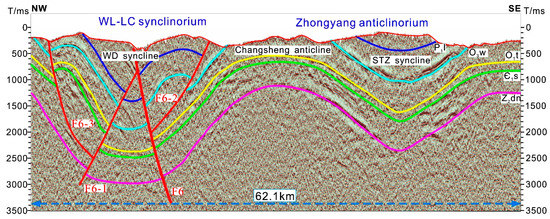
Figure 5.
Seismic interpretation profile of L2. (F6: Pengshui–Jianshin fault).
Wulong syncline an overall wide and gentle syncline structure which is located in WL-LC synclinorium. Its two wings are basically symmetrical and strike northeast. The syncline core is near the F5 fault, which can be seen from the NE section. It is cut into WL syncline and Huolu syncline by the F5 fault. From the NW seismic section, the characteristics of the two synclines are similar. The analysis shows that in the early Yanshan period, the strata were compressed in the SE-NW direction and formed a wide and gentle syncline in the NW direction. In the late Yanshan period, it was transformed by east–west compressive stress and divided into two independent synclines. As it is close to Qiyueshan fault zone, Wulong syncline fault is developed, and thrust forms a high, steep and narrow thrust structure, showing the characteristics of barrier fold. The exposed strata of WL syncline are Triassic, and the exposed strata of Huolu syncline are Permian (Figure 6).
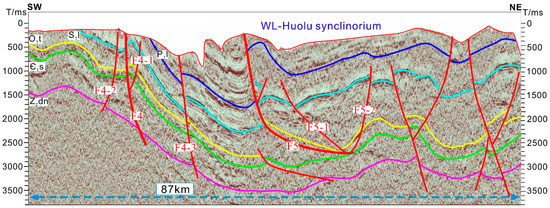
Figure 6.
Seismic interpretation profile of L1. (F4: Chayuan fault, F5: Hujiayuan fault).
5. Discussion
5.1. Impact on Shale Gas Preservation Conditions
5.1.1. Tectonic Condition
Southeast Chongqing has experienced the tectonic transformation of Caledonian movement, Hercynian movement, Indosinian movement, Yanshan movement and Himalayan movement [24]. Under the repeated lifting and stretching of Caledonian movement, the early structural pattern of alternating uplift and depression was formed, which is the main factor for the formation of fold deformation and multiple structural styles in the study area. The tectonic uplift of late Yanshan period caused the formation to be eroded and formed a widely distributed pattern of residual anticline and syncline alternately distributed. Among them, the axis of the residual anticline is narrow, the stratum is steep, and the stratum denudation degree is relatively high. Therefore, the residual anticline is generally small in scale and the internal structure of the stratum is relatively complex. The residual syncline has a wide extension, small stratum angle, simple structure and large area (Figure 7).
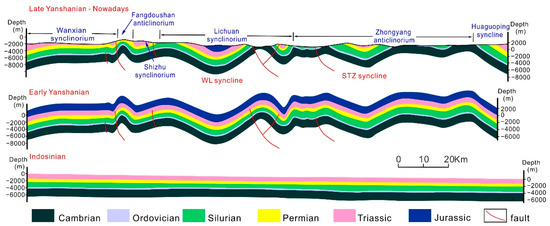
Figure 7.
Overpressure–atmospheric tectonic evolution section in southeast Chongqing.
Early uplifting and stretching, but with a small uplift and accompanied by a decline, the Early Silurian Longmaxi Formation has good preservation conditions. In the long-term tectonic evolution process (from late Yanshan to late), the Longmatai Formation shale had a limited variation in the overall buried depth, with an average depth of 4500–6500 m, while the maturity of the Longma Creek shale was over mature, and the average vitrinite reflectance (Ro) was more than 2.5. Until the late Yanshan, the tectonic uplift resulted in the massive erosion of the Longma Xi formation. The burial depth of the remnant syncline can reach 1500–3500 m and has relatively better preservation conditions.
Qiyueshan fault is the largest fault system in the study area. The whole fault system is a large thrust fault distributed in NE direction. Geologically, it is usually used as the boundary between inside and outside the Sichuan Basin [25]. The west side of Qiyueshan fault is mainly Nanchuan block, in which the Wufeng and Longmaxi Formations gradually show the characteristics of normal pressure as it is closer to Qiyueshan great fault. The east side of the Qiyueshan fault, such as Wulong and Pengshui blocks, is characterized by normal pressure, indicating that the fault system has a certain impact on the pressure relief of Wufeng-Longmaxi Formation. Therefore, Qiyueshan fault is also a sign of the transition of shale gas from overpressure to normal pressure in southeast Chongqing. Pengshui–Qianjiang fault system and Youyang–Xiushan fault system are also developed in the east, accompanied by many secondary faults, which have played a considerable destructive role in the preservation of shale gas.
The destruction of shale gas preservation conditions by faults is mainly manifested in the phenomenon of low resistance in logging. The shale with low fault damage in the study area is characterized by high gamma-ray and high resistance, and the shale with high damage is characterized by high gamma-ray and low resistance. For example, well PY1 is far away from large faults and has good gas content. The electrical property is characterized by high resistance, about 46–94 Ω·M. The resistivity of Silurian shale in the well RY1 near the fault is relatively low, and the shale quality of the 1–5 small section is only 1.8 to 1.2 Ω·M, averaging only 4.7 Ω·M. Field development results show that, for example, well SY2 is far away from the fault, the structure is stable, the construction process is relatively smooth, and there is mud leakage occasionally in the SY3 well near the fault. From the perspective of gas content, the gas content of wells closer to the fault is significantly lower than that of wells farther from the fault (Figure 8).
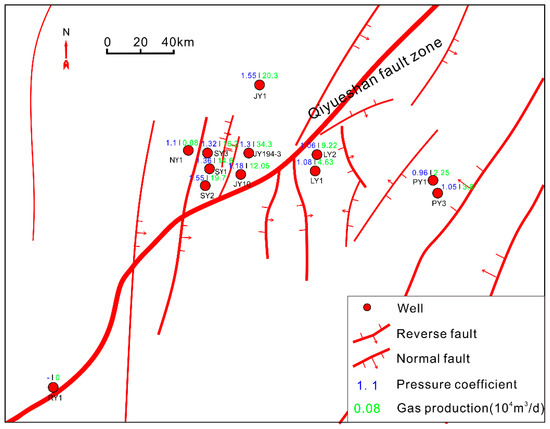
Figure 8.
The plane relationship between production wells and large faults. It includes the actual daily output of each well and the pressure coefficient of high-quality shale formation.
The preservation of natural gas is affected by structural factors such as the fold bending degree of shale formation, fault shape, denudation intensity and structural style. Generally, the shale formation with small tectonic action and wide and gentle formation has good natural gas preservation, such as the Changning–Weiyuan Wufeng–Longmaxi shale formations in the Sichuan Basin [26]. Due to the intense tectonic activity in southeast Chongqing, different tectonic styles are formed and superimposed by different stages of tectonic action, accompanied by serious stratum denudation. Due to the action of compressive stress, the study area mainly forms structural forms such as a hedge, back thrust structure and fault spreading fold. Continuous multiple faults cause poor gas content, smaller formation pressure and increased development risk.
5.1.2. Closure Condition
Shale formation itself is compact and has good sealing ability, in particular, the shale formation with deep burial depth and high formation pressure has better self-generating and self-reservoir ability [27]. However, for the characteristics of intense structural deformation, over mature hydrocarbons, serious uplift and denudation and formation pressure relief of Upper Paleozoic shale in southeast Chongqing, the roof and floor conditions of shale reservoir are very important for the preservation of shale gas.
The underlying stratum of Wufeng Formation is thin dense nodular limestone of Ordovician Linxiang formation, and below it is argillaceous limestone of Baota formation with large thickness. Even in the case of large structural angle, it is difficult for natural gas to dissipate laterally along this group of dense carbonate rocks. Therefore, the floor of Longmaxi–Wufeng shale is simple and well preserved.
The roof conditions of Longmaxi Formation are very complex. The overlying stratum of Longmaxi Formation in the study area is the Xiaoheba Formation, which is 50–80 m gray mudstone and siltstone, and the mudstone of the Hanjiadian Formation with a large thickness above it. As an indirect caprock, it has good compactness. Mainly affected by stratum uplift and denudation, the stratum at the top of the anticline core becomes thinner, and the stratum at the top of the two wings of the syncline becomes thinner from both ends of the mesophase until the target layer is exposed to the surface. Therefore, the thickness distribution of the shale gas cap rock in the study area is affected by the structural shape, the residual anticline core is behind the thin two wings and the reservoir is directly exposed. The residual syncline or residual slope caprock is thick in the middle and thin on both sides, and the stratum in the high part of the structure is directly exposed to the surface.
The thickness of the whole Longmaxi Formation is more than 200 m, but only the lower part of the Long 1 member is high-quality shale. Existing studies have divided the first section of Longmaxi Formation and Wufeng Formation including Fuling, Changning–Weiyuan and other gas fields into nine sub layers from the bottom of Wufeng Formation [28]. However, the determination of the top of the high-quality shale layer is not certain. It is generally believed that small layers from 1 5 are high-quality shale deposited in a deep-water shelf, but small layer 6 occasionally has good gas indication. As a whole, sub layer 6–7 is a mixed shale with a thickness of about 30 m, and sub layer 8–9 is a denser clayey shale with a thickness of about 50 m. Light gray argillaceous rock, yellow–gray yellow–green mudstone and silty mudstone are developed in the Longmaxi 2–3 section, with dense lithology and thickness of about 300 m (Figure 9). The porosity of layer 6 of well PY1 is 2.61%, and the vertical permeability is 0.625 × 10−3 um2, the porosity of the 7th sublayer is 2.90%, and the vertical permeability is 0.0486 × 10−3 um2. The average porosity of sublayer 8–9 is 3.50%, and the vertical permeability is 0.0055 × 10−3 um2. Therefore, the compactness of caprock can be guaranteed.
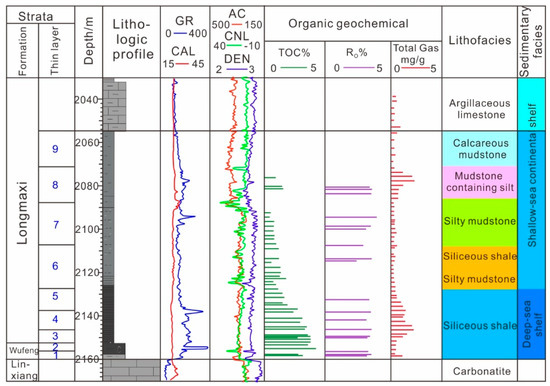
Figure 9.
Lithologic profile and geochemical characteristics of PY1.
Generally speaking, the direct caprock conditions in the area of high-quality shale are good. Even if the artificial transformation fracture is connected with the bottom layer of the roof in the process of production fracturing, it will not collude with the high-permeability area developed such as aquifer, but connect the poor gas reservoir, which helps to improve gas production rather than increase the development risk.
Authors should discuss the results and how they can be interpreted from the perspective of previous studies and of the working hypotheses. The findings and their implications should be discussed in the broadest context possible. Future research directions may also be highlighted.
5.1.3. Formation Mechanism of Nature Pressure Shale Gas
Formation pressure coefficient is not only an engineering factor considered in the development process, but also an intuitive response to the preservation conditions of shale gas [29]. Generally, there is a positive correlation between the actual gas production and the formation pressure coefficient (Figure 10).
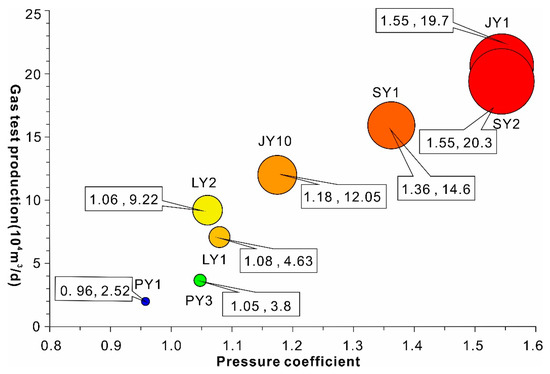
Figure 10.
Relationship between formation pressure coefficient and gas production.
The formation pressure of the Longmaxi Formation in the study area has experienced the transformation process from overpressure to normal pressure. The main mechanisms of overpressure formation in sedimentary basins include uneven compaction (under compaction), clay mineral dehydration, hydrocarbon generation (including liquid hydrocarbon cracking gas), hydrothermal pressurization and tectonism. Under compaction and hydrocarbon generation are the two main reasons for large-scale overpressure. The total organic carbon content of the the first section of Longmaxi Formation and Wufeng Formation in the study area is more than 2%, the maximum paleo burial depth of the formation is about 7000 m, the formation temperature is more than 200 °C, the organic matter matures, and the Ro reaches 2.0–3.0 (Figure 11). In this period, the strata not only experienced the peak of oil and gas generation, but also experienced the stage of oil and moisture cracking to generate dry gas. Therefore, hydrocarbon generation pressurization is the most important cause of pressurization in the burial stage of Silurian Longmaxi Formation. In the later stage, on the one hand, overpressure rupture makes the gas discharged, on the other hand, tectonic movement, fault activity, uplift and unloading lead to the leakage of natural gas and the formation of normal pressure. Due to the structural movement, the stratum folds and deforms, and the stratum angle increases. While forming faults, many large-scale fracture development zones are also produced, which virtually increases the permeability of the reservoir. Tectonic uplift leads to the denudation of the stratum, resulting in a large amount of leakage of natural gas from the residual stratum near the denudation surface to form atmospheric pressure. Therefore, the farther away from the denudation point, the better the gas content.
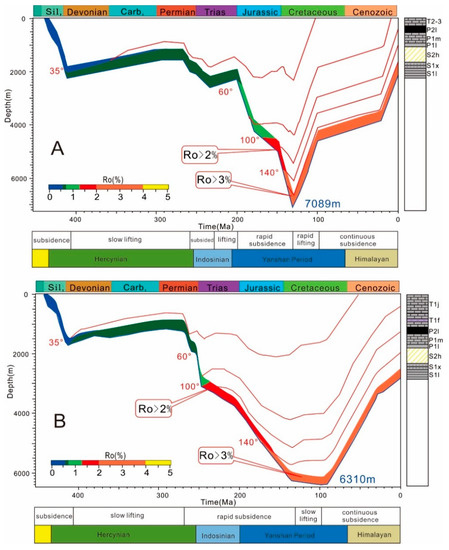
Figure 11.
Buried curve of the Longmaxi Formation in southeast Chongqing. (A): well PY1, (B): well LY1.
The regional distribution characteristics of shale gas in an overpressure area and a normal pressure area are obviously different. The formation pressure coefficient of Longmaxi Formation in the Nanchuan block is greater than 1.2, the pressure coefficient of well NY1 in the Nanchuan anticline is 1.35, the average pressure coefficient of the Pingqiao anticline is 1.3, and the pressure coefficient of the Pingqiao south slope is 1.1–1.25. The formation pressure coefficient decreases gradually along the southeast, and crosses the Qiyueshan fault to begin the transition from overpressure in the basin to normal pressure outside the basin. The pressure coefficient of the Wulong syncline in the east of the Qiyueshan fault is 1.0–1.3, which is less than 1.2 on average, the pressure coefficient of the Daozhen syncline is 1.0–1.2, and the pressure coefficient of the Sangtuoping syncline is 0.8–1.2 (Table 3). The relatively high formation pressure mainly exists in the areas with a large buried depth of large residual syncline, such as the Sangtuoping syncline and Daozhen syncline core (Figure 12). Shale gas in the overpressure area is distributed in well-preserved anticlines or slope zones. Gas-producing areas with a large distribution, such as the Pingqiao anticline, Pingqiao south slope, Dongsheng anticline and Jinfo slope, have continuous stratigraphic distribution, but the stratigraphic angle changes greatly. The anticline is narrow and steep with multiple faults accompanying the development, and the structural style is relatively complicated.
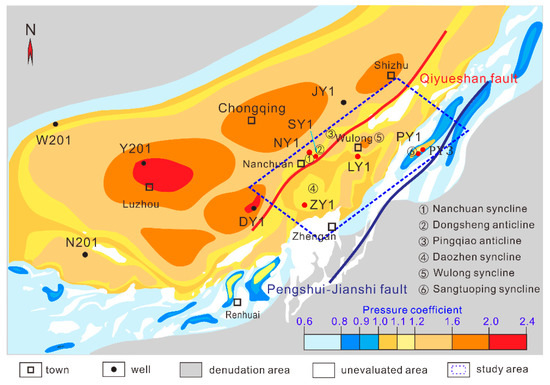
Figure 12.
Coefficient of formation pressure in and around the Sichuan Basin (revised from reference [14]).
The structural unit of the Longmaxi Formation with normal pressure characteristics mainly has one or more pressure relief factors, including complex structural turning area, serious stratum denudation, fault development and so on. The formation pressure coefficient depends on the degree of formation pressure relief. Therefore, the change of formation pressure from overpressure to atmospheric pressure in the Longmaxi Formation is a process of deterioration of preservation conditions. It can also be considered that the preservation conditions of shale gas outside the basin are worse than those in the basin.
5.2. Enrichment Model of Nature Pressure Shale Gas
The preservation of natural gas is affected by structural factors such as the fold bending degree of shale formation, fault shape, denudation intensity and structural style. Generally, the shale formation with small tectonic action and wide and gentle formation is well preserved in the weather, such as the shale formation of Changning–Weiyuan Wufeng–Longmaxi Formation in the Sichuan Basin [30]. Due to the intense tectonic activity in southeast Chongqing, different tectonic styles are formed and superimposed by different stages of tectonic action, accompanied by serious stratigraphic denudation. Continuous multiple faults cause poor gas content, smaller formation pressure and increased development risk. The late Yanshanian tectonic movement formed the structural pattern of alternating distribution of residual anticline and residual syncline in the study area (Figure 13A). The residual anticline stratum was denuded seriously, the stratum angle was large, and the faults were densely distributed, resulting in poor preservation conditions of shale gas. The residual syncline strata are well preserved and the fault distribution is relatively sparse (Figure 13B). At the same time, the formation angle is small and has good preservation conditions. For example, the strata of Longmaxi Formation in WL syncline and STZ syncline are relatively wide and gentle, and the gas content is considerable (Figure 13C). Residual slopes also exist widely, which are characterized by steep slopes and gentle downward strata. Natural gas usually escapes from the denudation surface or fault at the top of the slope and has a good gas-bearing property (Figure 13D).
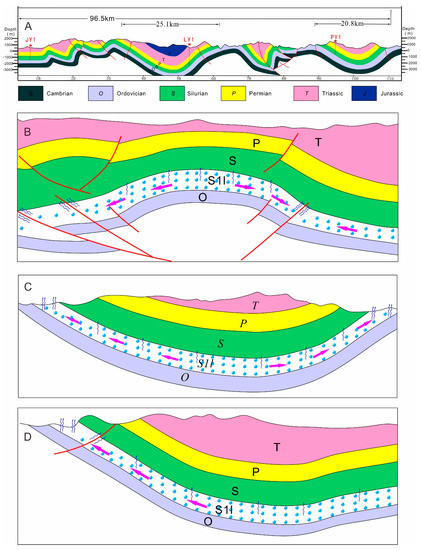
Figure 13.
Structural preservation styles of shale gas in southeast Chongqing. (A): Geological structure section of southeast Chongqing. (B): Reservoir forming model of anticline in basin. (C): Reservoir forming model of residual syncline outside the basin. (D): Reservoir forming model of residual slope outside the basin.
However, southeast Chongqing always belongs to the area with intense tectonic activity. The fine interpretation and identification of complex structural styles are the key link to reduce risks in the actual development process.
The advantage of this study is that it has formed a comparison between normal pressure shale gas and overpressure shale gas, which makes the research results more convincing. However, the research on the normal pressure area is basically based on a small amount of 2D seismic data, which is not accurate enough compared with 3D seismic data. This study on normal pressure area is limited to some areas of Chongqing, China, and the outward extension is not enough.
6. Summary and Conclusions
The basin margin transition zone in the southeast margin of the Sichuan Basin is located in the complex structural area of the basin margin. Structural conditions are the major factor affecting the preservation conditions of normal pressure shale gas in southeast Chongqing, and it is an important piece of content in order to study the preservation conditions of shale gas in the complex fold belt. The preservation conditions of shale in the Longmaxi Formation of Lower Silurian have been damaged to varying degrees by multi-stage tectonic movement. Tectonic processes such as uplift and denudation of strata have formed main shale gas preservation forms such as high and narrow residual anticline, wide and slow residual syncline and residual slope. Roof conditions of the Longmaxi–Wufeng Formation are relatively complex. The direct caprock of high-quality shale in the lower part has good preservation conditions, and the floor limestone is dense and well preserved. The normal pressure shale gas of Longmaxi Formation in eastern Chongqing is formed due to the loss of natural gas caused by uplift, denudation and fault development in the later stage. Its formation pressure transit from the basin to the outside of the basin and changes from overpressure to normal pressure, indicating that the preservation conditions of shale gas outside the basin are worse than those in the basin. On the whole, the Wufeng Formation–Longmaxi Formation in the basin margin transition zone has good preservation conditions, but the increase of natural gas loss from inside to outside the basin is an inevitable trend.
Author Contributions
Conceptualization, Y.L. and R.P.; methodology, Y.L. and J.J.; software, Z.Z.; validation, J.J.; investigation, Y.L. and X.L.; resources and data curation, Y.L.; writing—original draft preparation, Y.L.; writing—review and editing, R.P. and L.X.; supervision, R.P. All authors have read and agreed to the published version of the manuscript.
Funding
This research was funded by the National Science and Technology Major Project of China, grant number “2016ZX05061-001, 2016ZX05047-002 and 2016ZX05062-002”; National Natural Science Foundation of China Youth Fund (gran number 41804120).
Data Availability Statement
Not applicable.
Acknowledgments
Thanks for the data provided by Sinopec East China Oil and Gas Company.
Conflicts of Interest
The authors declare no conflict of interest.
References
- Ma, X.H. A golden era for natural gas development in the Sichuan Basin. Nat. Gas Ind. 2017, 4, 163–173. [Google Scholar] [CrossRef]
- Zou, C.N.; Yang, Z.; Sun, S.; Zhao, Q.; Bai, W.; Liu, H.; Pan, S.; Wu, S.; Yuan, Y. Exploring petroleum inside source kitchen: Shale oil and gas in the Sichuan Basin. Sci. China Earth Sci. 2020, 63, 934–953. [Google Scholar] [CrossRef]
- Zhai, G.; Wang, Y.; Bao, S.; Guo, T.; Zhou, Z.; Chen, X.; Wang, J. Major factors controlling the accumulation and high productivity of marine shale gas and prospect forecast in southern China. Earth Sci. 2017, 42, 1057–1068. [Google Scholar]
- Guo, X.S. Rules of two-factors enrichment for marine shale gas in southern China Understanding from the Longmaxi formation shale gas in The Sichuan basin and its surrounding area. Acta Geol. Sin. 2014, 88, 1209–1218. [Google Scholar]
- Thanh, H.V.; Sugai, Y.; Nguele, R.; Sasaki, K. Integrated workflow in 3D geological model construction for evaluation of CO2 storage capacity of a fractured basement reservoir in Cuu Long Basin, Vietnam. Int. J. Greenh. Gas Control. 2019, 90, 102826. [Google Scholar] [CrossRef]
- Vo Thanh, H.; Sugai, Y.; Sasaki, K. Impact of a new geological modelling method on the enhancement of the CO2 storage assessment of E sequence of Nam Vang field, offshore Vietnam. Energy Sources Part A Recovery Util. Environ. Eff. 2020, 42, 1499–1512. [Google Scholar] [CrossRef]
- Jin, Z.; Cai, L. Exploration prospects problems, and strategies of marine oil and gas in China. Oil Gas Geol. 2006, 27, 722–730. [Google Scholar]
- Fang, Z. Challenges and countermeasures for exploration and development of normal pressure shale gas in southern China. Reserv. Eval. Dev. 2019, 9, 1–13. [Google Scholar]
- Nie, H.K.; He, Z.L.; Liu, G. Status and direction of shale gas exploration and development in China. J. China Univ. Min. Technol. 2020, 49, 13–35. [Google Scholar]
- Ran, T.; Tan, X.; Chen, H.; Wang, J.; Xue, W.; Chen, Q.; Zeng, C.; Chen, C. Geological characteristics of shale gas accumulation in the Lower Silurian Longmaxi Formation in southeastern Chongqing. Pet. Geol. Recovery 2017, 24, 17–26. [Google Scholar]
- Pan, R.F.; Li, X.T.; Jin, J.J.; Zhu, Z.Z.; Meng, J.H. Heterogeneity characteristics and controlling factors of normal-pressure shale gas reservoirs in the basin-margin transition zone of SE Chongqing. Nat. Gas Ind. 2018, 38, 26–36. [Google Scholar]
- Yuan, Y.S.; Fang, Z.X.; He, X.P.; Peng, Y.M.; Long, S.X. Normal pressure formation mechanism of Longmaxi shale gas in Pengshui and its adjacent areas. Reserv. Eval. Dev. 2020, 10, 9r16. [Google Scholar]
- Nie, H.K.; Wang, H.; He, Z.L.; Wang, R.; Zhang, P.; Peng, Y.M. Formation mechanism, distribution and exploration prospect of normal pressure shale gas reservoir: A case study of Wufeng formation-Longmaxi formation in The Sichuan basin and its periphery. Acta Pet. Sin. 2019, 40, 131–143, 164. [Google Scholar]
- He, X.P.; Gao, Y.Q.; Tang, X.; Zhang, P.; He, G. Analysis of major factors controlling the accumulation in normal pressure shale gas in the southeast of Chongqing. Nat. Gas Geosci. 2017, 28, 654–664. [Google Scholar]
- Fang, Z.X.; He, X.P. Formation and evolution of shale gas in the Wulong slanting normal pressure in southeastern Chongqing. Oil Gas Geol. 2016, 37, 819–827. [Google Scholar]
- He, Z.L.; Nie, H.K.; Zhang, Y. The main factors of shale gas enrichment of Ordovician Wufeng formation-Silurian Longmaxi formation in the The Sichuan basin and its adjacent areas. Earth Sci. Front. 2016, 23, 8–17. [Google Scholar]
- Peng, Y.M.; Long, S.X.; He, X.P.; Tang, J.; Nie, H.K.; Gao, Y.M.; Xue, G.; Fan, Y.; Liu, Y. Characteristics of normal-pressure shale gas reservoirs and evaluation of its favorable areas in Pengshui. Reserv. Eval. Dev. 2020, 10, 12–19. [Google Scholar]
- He, Z.L.; Hu, Z.Q.; Nie, H.K.; Li, S.J.; Xu, J. Characterization of shale gas enrichment in the Wufeng-Longmaxi formation in the The Sichuan Basin and its evaluation of geological construction-transformation evolution sequence. Nat. Gas Geosci. 2017, 28, 724–733. [Google Scholar] [CrossRef]
- He, G.S.; He, X.P.; Gao, Y.Q.; Wan, J.; Zhang, P.; Zhang, Y.; Gao, H. Enrichment model of normal-pressure shale gas in the Jinfo slope of the basin-margin transition zone in Southeast Chongqing. Nat. Gas Ind. 2020, 40, 50–60. [Google Scholar]
- Sun, M.D.; Yu, B.S.; Li, J.; Cao, X.M.; Xia, W. Features and Major Controlling Factors of Longmaxi Shale Reservoir in Southeastern Chongqing. Spec. Oil Gas Reserv. 2014, 21, 63–66. [Google Scholar]
- Nie, H.; Jin, Z.; Ma, X.; Liu, Z.; Lin, T.; Yang, Z. Graptolites zone and sedimentary characteristics of upper Ordovivian Wufeng formation-lower Silurian Longmaxi formation in The Sichuan basin and its adjacent areas. Acta Petrolei Sin. 2017, 38, 160–174. [Google Scholar]
- He, X.P.; Zhang, P.; Fang, D.Z.; Mei, J.; He, G.; Lu, B. Production characteristics of normal pressure shale gasin Pengshui-Wulong area, southeast Chongqing. Pet. Geol. Recovery Effic. 2018, 25, 72–79. [Google Scholar]
- He, X.P.; Wang, Y.H.; Wang, Y.Q.; Zhang, L.; Wang, K.; Gao, Y.; Liu, M. Exploration practices of normal-pressure shale gas in the marginal transition zone of the southeast The Sichuan Basin. China Pet. Explor. 2020, 25, 126–136. [Google Scholar]
- Cai, Z.R.; Xia, B.; Huang, Q.; Wan, Z. Comparative study of the tectonic setting on the formation and preservation of Paleozoic shale gas between the upper Yangtze and the lower Yangtze platforms. Nat. Gas Geosci. 2015, 26, 1446–1454. [Google Scholar]
- Li, S.J.; Li, Y.; He, Z. Differential deformation on two sides of Qiyueshan Fault along the eastern margin of The Sichuan Basin, China, and its influence on shale gas preservation. Mar. Pet. Geol. 2020, 121, 104602. [Google Scholar] [CrossRef]
- Zhang, J.C.; Nie, H.K.; Xu, B. Geological Condition of Shale Gas Accumulation in The Sichuan Basin. Nat. Gas Ind. 2008, 28, 151–156. [Google Scholar]
- Powley, D.E. Pressures and hydrogeology in petroleum basins. Earth Sci. Rev. 1990, 79, 215–226. [Google Scholar] [CrossRef]
- Zhao, W.; Jing, T.; Wu, B.; Zhou, Y.; Xiong, X. Controlling mechanism of faults on the preservation conditions of shale gas: A case study of Wufeng-Longmaxi Formation in Southeast Chongqing. Gas Geosci. 2018, 29, 1333–1344. [Google Scholar]
- Dong, D.; Wang, Y.; Li, X.; Zou, C.; Guan, Q.; Zhang, C.; Huang, J.; Wang, S.; Wang, H.; Liu, H.; et al. Breakthrough and prospect of shale gas exploration and development in China. Nat. Gas Ind. 2016, 36, 19–32. [Google Scholar] [CrossRef] [Green Version]
- Guo, T.L. Evaluation of highly thermally mature shale-gas reservoirs in complex structural parts of the The Sichuan Basin. J. Earth Sci. 2013, 24, 863–873. [Google Scholar] [CrossRef]
Publisher’s Note: MDPI stays neutral with regard to jurisdictional claims in published maps and institutional affiliations. |
© 2022 by the authors. Licensee MDPI, Basel, Switzerland. This article is an open access article distributed under the terms and conditions of the Creative Commons Attribution (CC BY) license (https://creativecommons.org/licenses/by/4.0/).